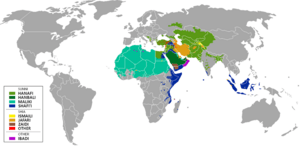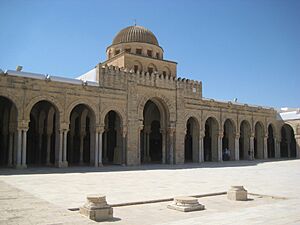Maliki school facts for kids
The Maliki school (Arabic: مَالِكِي) is one of the four main ways of understanding Islamic law within Sunni Islam. It was started by a scholar named Malik ibn Anas in the 700s.
The Maliki school uses the Quran (the holy book of Islam) and hadiths (sayings and actions of Prophet Muhammad) as its main sources. What makes it special is that it also looks at what the people of Medina agreed upon. This agreement is seen as a valid source for Islamic law.
The Maliki school is one of the biggest groups of Sunni Muslims. It has many followers, similar to the Shafi`i school, but it's smaller than the Hanafi school. You can find Maliki Sharia mostly in North Africa (except parts of Egypt), West Africa, Chad, Sudan, Kuwait, Bahrain, Qatar, Emirate of Dubai in the UAE, and some parts of northeastern Saudi Arabia.
Long ago, in the Middle Ages, the Maliki school was also important in parts of Europe ruled by Muslims. This included Islamic Spain and the Emirate of Sicily. A very important place for Maliki teachings from the 800s to the 1000s was the Mosque of Uqba in Tunisia.
Contents
History of the Maliki School
Even though Malik ibn Anas was from Medina, his school faced strong competition in the Muslim East. The Shafi'i, Hanbali, and Zahiri schools became more popular there. Eventually, the Hanafi school became the official choice of the Abbasid government.
Imam Malik was a teacher of Imam Ash-Shafi‘i. Imam Ash-Shafi’i then taught Imam Ahmad ibn Hanbal. Imam Malik was also a student of Imam Ja'far al-Sadiq. Ja'far al-Sadiq was a descendant of the Islamic prophet Muhammad. This means all four great Imams of Sunni Fiqh (Islamic law) are connected to Ja'far.
The Maliki school became very successful in Africa. For a while, it was also strong in Spain and Sicily. Under the Umayyads, the Maliki school was promoted as the official law. Maliki judges had a lot of power over religious practices. In return, they were expected to support the government. This strong influence lasted in Spanish Andalus until the Almoravids.
The Sunnah (Prophet Muhammad's way of life) and Hadith (his sayings) were less important to some Maliki scholars. They sometimes viewed these with caution. Later, the Almohads, who followed a different school, took over. Malikis were still allowed but lost their official support. When the Reconquista happened, Muslims lost control of the Iberian Peninsula completely.
Even though Al-Andalus was lost, the Maliki school has stayed strong in North and West Africa. It has also been the preferred school in small Arab States of the Persian Gulf like Bahrain, Kuwait, and Qatar. While most of the United Arab Emirates and Saudi Arabia follow Hanbali laws, the Eastern Province of Saudi Arabia has been a Maliki area for centuries.
At first, Malikis were not keen on mystical practices. But over time, they learned to live with Sufi customs. Sufism became very popular in North and West Africa. Today, many Muslims follow both Maliki law and a Sufi order.
How Maliki Law is Made
The Maliki school uses different sources to make Sharia rulings. These sources are used in a specific order:
- First, they look at the Quran.
- Then, they use trustworthy Hadiths (sayings, customs, and actions of Muhammad).
- If these are not clear, they look at `Amal (the customs and practices of the people of Medina).
- Next, they consider the agreement of the Sahabah (the companions of Muhammad).
- After that, they use individual opinions from the Sahabah.
- Then comes Qiyas (analogy, comparing new situations to old ones).
- After that is Istislah (what is best for Islam and Muslims).
- Finally, they use Urf (customs of people across the Muslim world), as long as it doesn't go against higher sources.
The Maliki school mainly comes from the work of Malik ibn Anas. His most important book is the Muwatta Imam Malik, also called Al-Muwatta. This book includes reliable Hadiths and Malik ibn Anas's comments. It is so complete that the Maliki school considers it a strong hadith source itself. Malik included the practices of the people of Medina. He showed how these practices matched or differed from reported hadiths.
This is because Malik believed that the practices of Medina's first three generations were a better proof of the "living" sunnah (Prophet's way) than single hadiths, even if they were sound. Malik was very careful about checking his sources. His collection of hadiths, al-Muwaṭṭah, was quite small. An example of the Maliki approach is using the opinion of the Sahabah. This was recorded in Muwatta Imam Malik for rules about eating Gazelle meat. This tradition came from the opinion of Zubayr ibn al-Awwam. Malik also used the daily practices of az-Zubayr as a source of "living sunnah" for his rulings.
Another important source is the Al-Mudawwana. This book was created by Malik's student, Ibn Qāsim, and his student, Sahnun. The Mudawwanah contains Ibn Qāsim's notes from his lessons with Malik. It also has answers to legal questions asked by Saḥnūn. In these answers, Ibn Qāsim quotes Malik. If he had no notes, he used his own legal reasoning based on Malik's teachings. These two books, the Muwaṭṭah and Mudawwanah, along with others from Malik's students, formed the basis for the later Maliki madhhab (school of thought).
The Maliki school is quite similar to the Hanafi school. The main differences are in how much weight they give to certain sources. Unlike the Hanafi school, the Maliki school doesn't rely as much on analogy. Instead, it uses a practical approach, focusing on istislah (public interest). This is used when the Quran and reliable Hadiths don't give clear guidance.
Key Differences from Other Schools
The Maliki school stands out from other Sunni law schools mainly in the sources it uses. Like all Sunni schools, the Maliki school uses the Qur'an as its main source. Then it uses the sayings, customs, and practices of Muhammad, found in hadiths. In the Mālikī school, this tradition also includes the legal rulings of the four rightly guided caliphs, especially Umar.
Malik bin Anas himself also accepted binding consensus and analogical reasoning. Most Sunni scholars agree with this, but Malik had conditions. Consensus was only accepted if it came from the first generation of Muslims. Or, it could come from the first, second, or third generations from Medina. Analogy was only used as a last choice if an answer wasn't found in other sources.
Important Maliki Scholars
Here are some notable scholars who followed the Maliki school:
- Ibn Abd al-Hakam (died 829), an Egyptian scholar who helped develop the Maliki school in Egypt.
- Asbagh ibn al-Faraj (died 840), another Egyptian scholar.
- Yahya al-Laithi (died 848), a scholar from Spain who brought the Maliki school to Al-Andalus.
- Sahnun (776–855), a Sunni jurist and author of the Mudawwanah, a very important book in Maliki law.
- Abd al-Malik ibn Habīb (790–853), a student of Malik's direct students. He gathered Malik's opinions in his al-Wādiḥah, a key book for Maliki law in Spain and North Africa.
- Ibn Abi Zayd (922–996), a Tunisian Sunni jurist and author of the Risālah, a standard Maliki law book.
- Yusuf ibn abd al-Barr (978–1071), a scholar from Spain.
- Ibn Tashfin (1061–1106), a leader of the Almoravid dynasty.
- Qadi Ayyad (died 1149), a great Imam and judge in Maliki law.
- Ibn Rushd (Averroes) (1126–1198), a famous philosopher and scholar.
- Al-Qurtubi (1214–1273).
- Shihab al-Din al-Qarafi (1228–1285), a Moroccan jurist and author who lived in Egypt.
- Khalil ibn Ishaq al-Jundi (died around 1365), an Egyptian jurist, author of Mukhtasar.
- Ibn Battuta (1304–1377), a famous explorer.
- Ibn Khaldūn (1332–1406), a scholar, historian, and author of the Muqaddimah.
- Abu Ishaq al-Shatibi (died 1388), a famous Maliki jurist from Spain.
- Sidi Boushaki (died 1453), a famous Algerian Maliki jurist.
- Sidi Abd al-Rahman al-Tha'alibi (died 1479), a famous Algerian Maliki jurist.
Modern Maliki Scholars
- Usman dan Fodio (1754–1817), who started the Sokoto Caliphate.
- El Hadj Umar Tall (1794–1864), who founded the Toucouleur Empire.
- Emir Abdelkader (1808–1883), an Algerian Sufi and political leader who fought against the French invasion.
- Ahmad al-Alawi (1869–1934), an Algerian Sufi leader.
- Omar Mukhtar (1862–1931), a Libyan resistance leader.
- Muhammad Ibn 'Abd al-Karim al-Khattabi, a Moroccan resistance leader.
- Abu-Abdullah Adelabu.
- Abdalqadir as-Sufi (1930–2021), a Scottish shaykh and founder of the Murabitun World Movement.
- Abdullahi Aliyu Sumaila.
- Ahmed Saad Al-Azhari, a British Islamic scholar. He used to follow the Shafi’i school but later adopted the Maliki school.
- Muḥammad al Tahir ibn Ashur (1879-1973), a Tunisian Islamic Scholar and Shariah Judge.
See also
 In Spanish: Malikí para niños
In Spanish: Malikí para niños
- Outline of Islam
- Glossary of Islam
- List of Islamic scholars
- The Seven Fuqaha of Medina
- Malikism in Algeria
- Adhan
- Islamic views on sin



